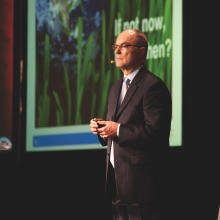

Photo by Sandra Strangemore
The notion of observing Earth Day with all the due solemn and thoughtful respect the occasion deserves has certainly come a long way in the 40 years of its existence.
And there was fittingly no shortage of expression of earnest commitment to the cause among more than 700 CPG (consumer packaged goods) and packaging industry professionals gathered last month at the Toronto Congress Centre on April 22, 2010, for the fourth annual Walmart Sustainable Packaging Conference, where Canada’s largest retailer reaffirmed its commitment to doing all in its power to fulfill the Big Three environmental pledges it vowed four years ago:
• Be a zero-waste company;
• Use only renewable energy;
• Maintain a fully-sustainable supply chain.
But unlike at the previous three conferences— organized jointly with the Toronto-based PAC-The Packaging Association—last month’s get-together was far less of a communal green love-in than a pointed rallying cry for Walmart Canada’s supplier base to start getting its act together on packaging reduction and sustainability in a meaningful way.
With the 2013 deadline for meeting Walmart’s Packaging Scorecard supplier evaluation system’s end-goal of a five percent global packaging reduction now in fast approach, senior Walmart Canada Corp. executives made no secret of their impatience with the lack of pace and progress displayed by its vendors on that front to date.

Photo by Sandra Strangemore
The fact that only about 20 per cent of the products sold at Walmart’s Canadian stores have even been entered into the Packaging Scorecard system at all so far is clearly not sitting well with a company that has made environmental sustainability one of its very core corporate values and cause célèbres.
“We want every package that comes into our stores entered into the Packaging Scorecard by July 1 of this year,” Walmart Canada’s supply-chain vice-president Guy McGuffin told the attendees, stressing the company’s dramatically shifted focus from mere supplier engagement to demanding real demonstrated commitment and resolve.
“And starting this year, we also want you to provide us with regular updates on what you’re doing with your packages to achieve your Packaging Scorecard targets and objectives,” McGuffin added.
“The target year 2013 is starting to loom large, and we’re challenging you to be prepared to help us reach our goal,” McGuffin urged the audience, while citing the 10.3-per cent packaging weight reduction that Walmart itself achieved last year with the relaunch of its Great Value store brand product range.
Being able to channel these savings into lower prices for Walmart Canada’s estimated one million daily customers, McGuffin argued, makes a perfect business case for using packaging sustainability to fulfill the company’s open-ended corporate mission of offering consumers low prices for its products, along with a growing range of environmentally-friendly alternatives.

Photo by Sandra Strangemore
“It is very important to have sustainability align with your business objectives,” he stressed. “When you start realizing financial benefits from doing the right thing for the environment, you’re really on your way.”
For Walmart Canada’s recently-appointed chief merchandising officer Duncan MacNaughton, concerted packaging reduction goes hand-in-hand with the company’s aggressive pricing strategy that underpins its business model.
“Our business is all about being able to offer unbeatable prices,” he stated, “and we can only do that by achieving internal cost-savings, which we use to lower prices, which we then use to drive our sales.”
The relentless drive to eliminate all internal waste throughout the company’s outlets is spearheaded by Walmart Canada’s headquarters operations in Mississauga, Ont., MacNaughton related, where hundreds of the company’s “associates,” including president and chief executive David Cheesewright, are actively engaged in the so-called ‘Personal Sustainability Programs’ (PSPs) that encourage employees to set personal goals for themselves that can drive positive environmental change in their daily lives, both at work and home.
For Cheesewright, for example, that means cycling to work at least once a week, McNaughton revealed.
“Let me assure you that the stress of seeing sales numbers at the end of the working day does not even close to the stress I feel when seeing my boss (Cheesewright) in the office wearing tight cycling shorts at 6:30 in the morning,” he chuckled. “But that’s what it’s all about for us at Walmart,” MacNaughton proclaimed. “We employ about 2.2-million people globally, and the estimated 200,000 of our associates who have their own PSPs are making a tremendous difference in helping us become a zero-waste business.
Advertisement

